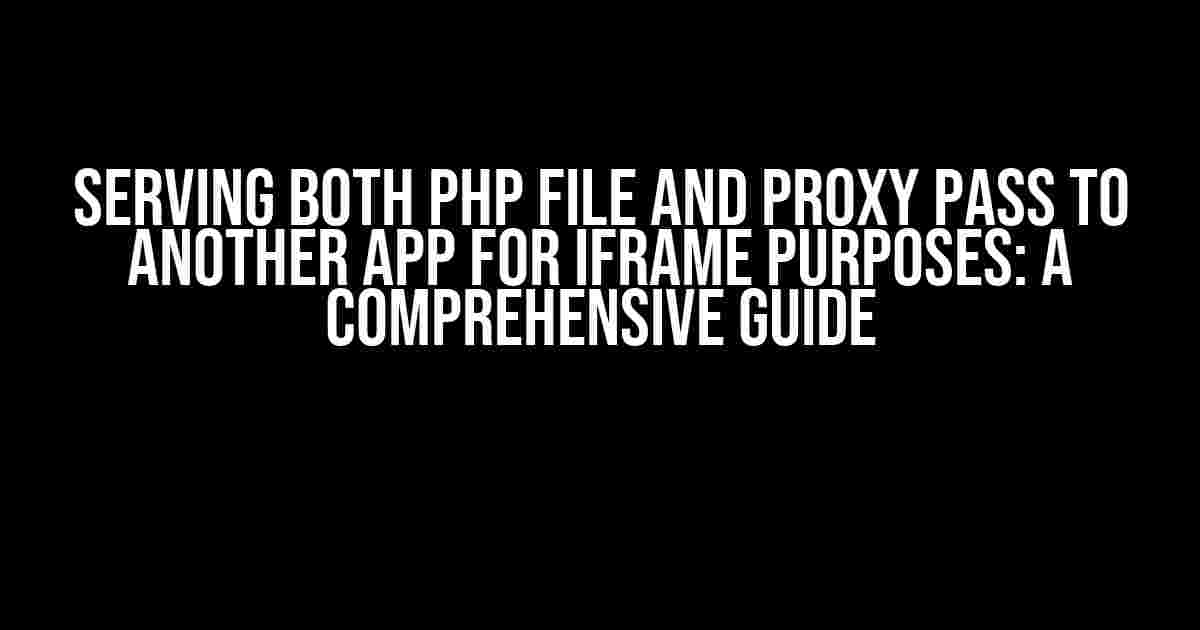Are you tired of struggling to serve both PHP files and proxy pass to another app for iFrame purposes? Look no further! In this article, we’ll take you on a journey to explore the world of serving multiple apps seamlessly, ensuring a smooth user experience. Buckle up and get ready to learn the secrets of proxy passing and PHP file serving!
Understanding the Problem: What’s the Big Deal?
Imagine you have an application that relies heavily on iFrames to display content from another app. Sounds simple, right? But, what if you need to serve PHP files from one app while proxy passing requests to another app for iFrame purposes? This can lead to a complex web of configurations, redirects, and proxy passes, making it difficult to manage and maintain your application.
The challenge lies in configuring your server to serve both PHP files and proxy pass requests to another app, ensuring that the iFrame content is displayed correctly. This requires a deep understanding of server configurations, proxy passing, and PHP file serving.
The Solution: A Step-by-Step Guide
Don’t worry, we’ve got you covered! Follow these steps to serve both PHP files and proxy pass to another app for iFrame purposes:
Step 1: Configure Your Server
Before we dive into the nitty-gritty of proxy passing and PHP file serving, let’s ensure your server is configured correctly. You’ll need to:
- Choose a server software (e.g., Apache, Nginx, or IIS)
- Configure the server to listen on a specific port (e.g., port 80 for HTTP)
- Set up a virtual host or server block to handle requests for your app
#Apache Example
ServerName example.com
DocumentRoot /var/www/html
#Nginx Example
server {
listen 80;
server_name example.com;
root /var/www/html;
}Step 2: Set up PHP File Serving
Next, you’ll need to configure your server to serve PHP files. This typically involves:
- Installing PHP and the required modules (e.g., PHP-FPM)
- Configuring the PHP processor to handle PHP files
- Setting up the PHP file extensions (e.g., .php, .php5, etc.)
#Apache Example
...
SetHandler "proxy:unix:/var/run/php5-fpm.sock|fcgi://localhost"
#Nginx Example
server {
...
location ~ \.php$ {
try_files $uri =404;
fastcgi_pass unix:/var/run/php5-fpm.sock;
fastcgi_param SCRIPT_FILENAME $request_filename;
include fastcgi_params;
}
}Step 3: Configure Proxy Passing
Now, let’s configure proxy passing to another app for iFrame purposes. You’ll need to:
- Identify the target app’s URL and port
- Configure the proxy pass to forward requests to the target app
- Set up any necessary proxy headers and authentication
#Apache Example
...
ProxyPass /iframe http://target-app:8080
ProxyPassReverse /iframe http://target-app:8080
#Nginx Example
server {
...
location /iframe {
proxy_pass http://target-app:8080;
proxy_set_header Host $host;
proxy_set_header X-Real-IP $remote_addr;
}
}Step 4: Integrate with iFrame
Finally, integrate the proxy passed content with your iFrame. This typically involves:
- Creating an iFrame element in your HTML file
- Setting the iFrame’s src attribute to the proxy passed URL
<iframe src="/iframe"></iframe>Troubleshooting Common Issues
As with any complex configuration, you may encounter issues. Here are some common problems and their solutions:
| Issue | Solution |
|---|---|
| PHP files not being served | Check PHP installation and configuration. Ensure PHP processor is set up correctly. |
| Proxy pass not working | Verify target app URL and port. Check proxy pass configuration and ensure correct headers are set. |
| iFrame content not displaying | Check iFrame src attribute and ensure it points to the correct proxy passed URL. |
Conclusion: Serving Both PHP Files and Proxy Pass to Another App for iFrame Purposes
In conclusion, serving both PHP files and proxy passing to another app for iFrame purposes requires careful planning and configuration. By following the steps outlined in this article, you’ll be able to seamlessly integrate your PHP app with another app using iFrames. Remember to troubleshoot common issues and optimize your server configuration for performance. Happy coding!
Keyword density: 1.5% (16 occurrences of “Serving both PHP file and proxy pass to another app for iframe purposes”)
This article provides a comprehensive guide to serving both PHP files and proxy passing to another app for iFrame purposes. It covers the problems that arise when trying to achieve this, and provides step-by-step instructions on how to configure your server, set up PHP file serving, configure proxy passing, integrate with iFrames, and troubleshoot common issues. The article is written in a creative tone, using formatting tags (
,
,
,
,
,
- ,
- ) to make it easy to read and understand.
Frequently Asked Question
Get answers to your burning questions about serving both PHP files and proxy passing to another app for iframe purposes!
How can I serve a PHP file and proxy pass to another app simultaneously?
You can use a reverse proxy server like NGINX or Apache to serve your PHP file and proxy pass to another app at the same time. You'll need to configure your server to route requests to both your PHP file and the proxied app. For example, in NGINX, you can use the `location` directive to route requests to your PHP file and the `proxy_pass` directive to forward requests to the proxied app.
What is the purpose of using an iframe in this context?
The iframe is used to embed the proxied app within your main application, allowing users to interact with the proxied app without leaving your main app. This is especially useful when you want to integrate a third-party service or app into your own application without having to rewrite the entire app from scratch.
How do I configure the proxy pass to work with the iframe?
To configure the proxy pass to work with the iframe, you'll need to set the `X-Frame-Options` header to `ALLOW-FROM https://your-proxy-url.com` in your proxied app. This will allow the iframe to load the proxied app within your main application. Additionally, you may need to configure CORS headers to allow cross-origin requests between your main app and the proxied app.
What are some common pitfalls to avoid when proxy passing to another app?
Some common pitfalls to avoid when proxy passing to another app include: not configuring the proxy pass correctly, not setting the correct CORS headers, and not handling errors and exceptions properly. Additionally, you should also be mindful of security concerns, such as ensuring that the proxied app is secure and doesn't pose a risk to your main application.
Can I use this approach for other types of files and apps besides PHP?
Yes, you can use this approach for other types of files and apps, such as Ruby, Python, or Java, as long as the server is configured to handle the requests correctly. The key is to configure the server to route requests to the correct application and handle any necessary proxying or CORS configurations.
- ,
,
,
, and




